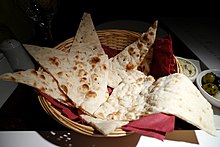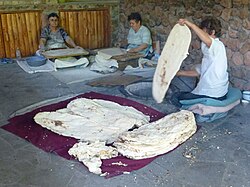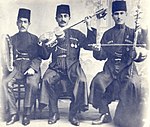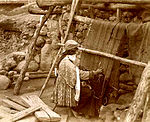food.wikisort.org - Dish
Lavash (Armenian: լավաշ) is a thin flatbread[9] usually leavened, traditionally baked in a tandoor (tonir) or on a sajj, and common to the cuisines of South Caucasus, Western Asia, and the areas surrounding the Caspian Sea.[10][11][12] Lavash is one of the most widespread types of bread in Armenia, Azerbaijan, Iran and Turkey.[13] The traditional recipe can be adapted to the modern kitchen by using a griddle or wok instead of the tonir.[14]
 | |
| Type | Flatbread |
|---|---|
| Place of origin | Armenia[1][2][3][4][5] or Iran[6][7][8] |
| Serving temperature | Hot or cold |
| Lavash, the preparation, meaning and appearance of traditional bread as an expression of culture in Armenia | |
|---|---|
UNESCO Intangible Cultural Heritage | |
 Lavash making in Armenia | |
| Country | Armenia |
| Domains | Food |
| Reference | 985 |
| Region | Europe and North America |
| Inscription history | |
| Inscription | 2014 (9th session) |
| Flatbread making and sharing culture: Lavash, Katyrma, Jupka, Yufka | |
|---|---|
UNESCO Intangible Cultural Heritage | |
 Lavash making in Lahıc, Ismailli, Azerbaijan | |
| Country | Azerbaijan, Iran, Kazakhstan, Kyrgyzstan and Turkey |
| Domains | Food |
| Reference | 1181 |
| Region | Europe and North America |
| Inscription history | |
| Inscription | 2016 (11th session) |
In 2014, "Lavash, the preparation, meaning and appearance of traditional bread as an expression of culture in Armenia" was inscribed in the UNESCO Representative List of the Intangible Cultural Heritage of Humanity.[15] In 2016, making and sharing flatbread (lavash, katyrma, jupka or yufka) in communities of Azerbaijan, Iran, Kazakhstan, Kyrgyzstan and Turkey was inscribed on the list as well.[16] Lavash is similar to yufka, but in Turkish cuisine lavash (lavaş) is prepared with a yeast dough while yufka is typically unleavened.[17]
Origin
According to The American Heritage Dictionary of the English Language lavash is "a thin unleavened flatbread of Armenian origin".[18] In 2014, Lavash was described by the Intangible Cultural Heritage of Humanity as "an expression of Armenian culture". This decision led to protests in Azerbaijan, Iran, Kyrgyzstan, and Kazakhstan over claims that the food was "regional", not "Armenian".[19][20]
The origin of lavash is often attributed to Armenia,[21][3][22][5] but some scholars say lavash probably originated in Iran.[23][7][24] Food historian Gil Marks identifies the origin more generally as the Middle East.[11]
History
Gil Marks traces the history of lavash to the early innovation of cooking thin flatbreads on terracotta griddles. The earliest forms of bread were cooked as cakes either on heated rocks or in embers, but when griddles started to be used breads had to be made thinner to fully cook through without burning like the bread rakik described in the Bible. With the innovation of early ovens, thicker loaves became possible.[11]
Etymology
Hrach Martirosyan tentatively connects Armenian լավաշ lavaš with dialectal լափ lapʿ, լուփ lupʿ, լովազ lovaz ‘palm, flat of the hand’, լափուկ lapʿuk, լեփուկ lepʿuk ‘flat, polished stone for playing’, լավազ lavaz ‘very thin’ and assumes derivation from Proto-Armenian *law- ‘flat’. He remarks that semantically this is conceivable since this bread is specifically flat and thin.[25] It is sometimes spelt Lavosh in English.
Sevan Nişanyan connects both Armenian, Turkish words for lavash ultimately to Aramaic לושׁ (lwš) root meaning "to knead".[26]
Preparation
Lavash is made with flour, water, yeast, sugar and salt. It can also be made in an unleavened version by omitting sugar and yeast.[27] Toasted sesame seeds and/or poppy seeds are sometimes sprinkled on before baking. Traditionally the dough is rolled out flat and slapped against the hot walls of a clay oven, but modern recipes may adapt for cooking on a wok or tava.
Usage
While quite flexible when fresh, lavash dries out quickly and becomes brittle and hard. The soft form is easier to use when making wrap sandwiches.
In Armenian villages, dried lavash is stacked high in layers to be used later, and when the time comes to rehydrate the bread, it is sprinkled with water to make it softer again. The dried bread is broken up into khash, while fresh lavash is used to wrap the Armenian specialty dish khorovats and to make other wraps with herbs and cheese.
In Iran, Turkey and some Middle Eastern countries lavash is used with kebabs to make dürüm wraps like tantuni. In its dry form, leftover lavash is used in Iran to make quick meals after being rehydrated with water, butter, or cheese.
In Turkish cuisine lavaş can be used also for sweet dishes and served alongside some traditional Turkish dessert dishes like kaysefe, hasude, pestil kavurması (braised fruit leather), ağuz and helva.[28]
In modern recipes lavash can be used like pizza dough.[29]
Traditions and customs
In Sabirabad District of Azerbaijan after a wedding when the bride comes into her new house, her mother-in-law puts lavash on her shoulder and says: "Let you come to the house of wealth, let your foot be lucky".[30] In the Novkhani settlement, after a funeral, it is customary for people to prepare kyulchya, which sometimes consists of halva wrapped up in lavash.[31]
Dried lavash can be stored over a long time period (almost one year) and is used instead of leavened bread[citation needed] in Eucharist traditions by the Armenian Apostolic Church.[citation needed]
In art
Women baking lavash is a common theme that has inspired Armenian painters. One such portrait by the famous Soviet-era painter Minas Minassian is displayed at the National Museum of Art in Yerevan. A print of the painting Armenian Ladies Baking Lavash by Armenian American artist Manuel Tolegian was selected by U.S. President Gerald Ford to hang in the White House Bicentennial Collection. The weekend open-air arts-and-crafts market in downtown Yerevan offers many lavash-related paintings and handiworks, with renditions of happy women making lavash having become a common sight. [32]
See also
- Barbari bread, a popular type of Iranian bread
- Chapati, an unleavened South Asian flatbread, made on a tava
- Markouk, an unleavened flatbread common in the Levant, made on a saj
- Matnakash, a traditional leavened Armenian bread
- Sangak, a type of leavened Iranian flatbread, made in an oven
- Taftan, a thicker leavened Iranian bread
- Tandyr nan, a Central Asian leavened bread made in a tandoor
- Naan, a leavened flatbread made in a tandoor or on a tava
- Tortilla
- Laffa
References
- "Lavash". The American Heritage Dictionary.
- Sergio O. Serna-Saldivar (2012). Cereal Grains: Laboratory Reference and Procedures Manual. CRC Press. p. 217. ISBN 9781439855652.
Lavash is another popular flat cracker bread with ancient roots in Armenia.
- Albala, Ken (ed.). Food Cultures of the World Encyclopedia, Volume 1. Santa Barbara, California: Greenwood Press. p. 5. ISBN 9780313376269.
...on lavash, a traditional flatbread of Armenia similar to tortilla...
- Goldstein, Darra (1999). A Taste of Russia: A Cookbook of Russian Hospitality (2nd ed.). Montpelier, VT: Russian Life Books. p. 185. ISBN 9781880100424.
Armenian Flat Bread Lavash: Lavash has been baked for centuries in Armenia.
- Khanam, R. (2005). Encycl. Ethnography Of Middle-East And Central Asia (3 Vols. Set) (1st ed.). New Delhi: Global Vision. p. 55. ISBN 9788182200623.
The t'onir is a round hole dug in the ground, which can be used for baking Armenian flat bread (lavash) and for heating the home in winter.
- Karizaki, Vahid Mohammadpour (2017-03-01). "Ethnic and traditional Iranian breads: different types, and historical and cultural aspects". Journal of Ethnic Foods. 4 (1): 8–14. doi:10.1016/j.jef.2017.01.002. ISSN 2352-6181.
The origin of lavash is most probably from Iran, according to the state of the encyclopedia of Jewish food.
- Marks, Gil (2010). Encyclopedia of Jewish Food. Houghton Mifflin Harcourt. p. 355. ISBN 978-0470391303.
- Reinhart, Peter (2011). The Bread Baker's Apprentice: Mastering the Art of Extraordinary Bread. Potter/TenSpeed/Harmony. p. 178. ISBN 978-1607741299.
Lavash, though usually called Armenian flatbread, also has Iranian roots (...)
- Kipfer, Barbara Ann (2012-04-11). The Culinarian: A Kitchen Desk Reference. Houghton Mifflin Harcourt (published 2012). p. 334. ISBN 9780544186033. Retrieved 2015-06-01.
LAVASH, LAVOSH, LAHVOSH, LAWAASH, or LAWASHA, also called ARMENIAN CRACKER BREAD, CRACKER BREAD, or PARAKI, is a round, thin Middle Eastern bread that is soft like a tortilla or hard like a cracker.
- Alan Davidson (1999). The Oxford Companion to Food. Oxford University Press. p. 456. ISBN 978-0192806819.
Lavash a thin crisp bread usually made with wheat flour made in a variety of shapes all over the regions of the South Caucasus, Iran (where it is often so thin as to be like tissue and can be almost seen through), and Afghanistan. It is leavened and baked in a tandoor. Lavash is served with kebabs and is used to scoop up food or wrap round food before being eaten. Its origins are ancient and it is also known as lavaş depending on the region. As in the other countries of this region large batches of this bread are made and stored for long periods. In Turkey they are stored on a board suspended by all four corners from the ceiling. The bread becomes dry and is restored by sprinkling with water and reheated as and when needed. Yufka is also a name for filo pastry.
- Gil Marks (2010). Encyclopedia of Jewish Food. John Wiley and Sons. p. 355.
- Morgan, Diane (2010). Skinny Dips. Chronicle Books. p. 14. ISBN 978-1452100241.
Lavash, lavosh, or lahvosh is a gigantic, paper-thin, blistery, tortilla-like flatbread common throughout Armenia, Turkey, and Iran.
- "Tastes of Memory: How to Bake an Authentic Armenian Lavash". Smithsonian.
- "Lavash". February 26, 2020.
- "Lavash, the preparation, meaning and appearance of traditional bread as an expression of culture in Armenia, Inscribed in 2014 (9.COM) on the Representative List of the Intangible Cultural Heritage of Humanity. Country(ies): Armenia". unesco.org. Retrieved 16 March 2016.
- "Flatbread making and sharing culture: Lavash, Katyrma, Jupka, Yufka". unesco.org. Retrieved 1 December 2016.
- "İNCE EKMEK YAPMA VE PAYLAŞMA KÜLTÜRÜ". Kültür Portalı.
- "Lavash". The American Heritage Dictionary.
- Lomsadze, Giorgi (December 3, 2014). "Armenia, Azerbaijan at Loggerheads Over Lavash". EurasiaNet. Retrieved December 10, 2016.
- McKernan, Bethan (27 October 2016). "A 'pizza war' has broken out between Turkey and Armenia". The Independent. Retrieved 10 December 2016.
- Sergio O. Serna-Saldivar (2012). Cereal Grains: Laboratory Reference and Procedures Manual. CRC Press. p. 217. ISBN 9781439855652.
Lavash is another popular flat cracker bread with ancient roots in Armenia.
- Goldstein, Darra (1999). A Taste of Russia: A Cookbook of Russian Hospitality (2nd ed.). Montpelier, VT: Russian Life Books. p. 185. ISBN 9781880100424.
Armenian Flat Bread Lavash: Lavash has been baked for centuries in Armenia.
- Karizaki, Vahid Mohammadpour (2017-03-01). "Ethnic and traditional Iranian breads: different types, and historical and cultural aspects". Journal of Ethnic Foods. 4 (1): 8–14. doi:10.1016/j.jef.2017.01.002. ISSN 2352-6181.
The origin of lavash is most probably from Iran, according to the state of the encyclopedia of Jewish food.
- Reinhart, Peter (2011). The Bread Baker's Apprentice: Mastering the Art of Extraordinary Bread. Potter/TenSpeed/Harmony. p. 178. ISBN 978-1607741299.
Lavash, though usually called Armenian flatbread, also has Iranian roots (...)
- Martirosyan, Hrach (2011). Etymological dictionary of the Armenian inherited lexicon. Brill. p. 305. ISBN 9789004173378.
- "lavaş". Nişanyan Sözlük. Retrieved 2020-05-24.
- "Mayasız lavaş ekmek tarifi". www.hurriyet.com.tr.
- Her Yönü ile Ani. TTOK. 2019.
- "Lavash Pizza With Tomatoes, Mozzarella and Goat Cheese". New York Times.
- Кулиева Н. М. Современная сельская семья и семейный быт в Азербайджане / Под ред. доктора исторических наук Т. Г. Мусаевой. — Б.: «Элм», 2011. — С. 97.
- Кулиева Н. М. Современная сельская семья и семейный быт в Азербайджане / Под ред. доктора исторических наук Т. Г. Мусаевой. — Б.: «Элм», 2011. — С. 122.
- "Lavash".
External links
- Lavash: Understanding Armenia's bread obsession
- On the Lavash Trail in Armenia
- Lavash in Dictionary.com
На других языках
- [en] Lavash
[ru] Лаваш
Лава́ш (азерб. и тур. lavaş, арм. լավաշ, груз. ლავაში, перс. لواش — lavâš, тат. lәvәş) — пресный белый хлеб в виде тонкой лепёшки из пшеничной муки, распространённый преимущественно у народов Кавказа, Балкан, и Среднего Востока.Другой контент может иметь иную лицензию. Перед использованием материалов сайта WikiSort.org внимательно изучите правила лицензирования конкретных элементов наполнения сайта.
WikiSort.org - проект по пересортировке и дополнению контента Википедии


